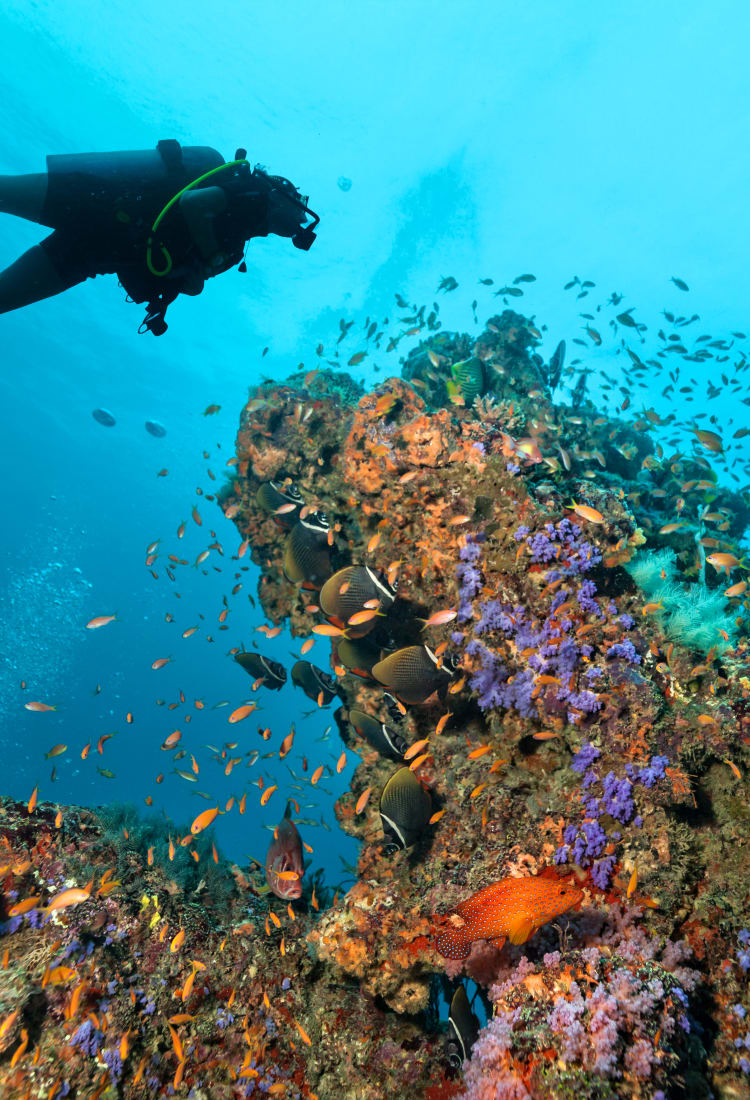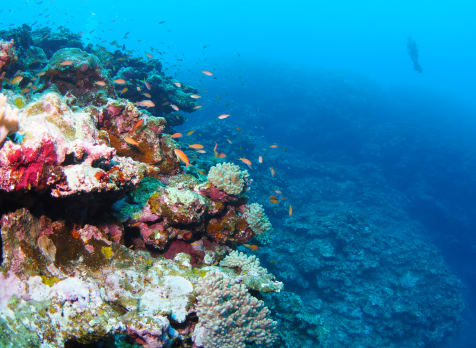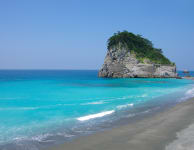

REISEFÜHRER Diving in Japan Divers in Japan can explore reefs, caves and even glaciers
The Japanese archipelago offers incredible diving variety

Asian countries such as the Philippines and Thailand get more attention for their diving spots, but Japan offers all sorts of great opportunities too. You can find ice diving near the northern island of Hokkaido and tropical locations down south. You can also try out cave diving at famous landmarks such as the Blue Cave on the main island of Okinawa, or wreck diving near a small island with a bridge from the main island. For those looking to stay a little closer to the surface, islands such as Ishigaki have great snorkeling options, with colorful coral reefs and an array of sea life.
The length of the island nation allows for a broad spectrum of diving opportunities, while a long history of volcanic activity has resulted in some very unusual underwater topography. Divers will encounter an array of fish and other critters during their expeditions, and depending on what time of the year you dive, you'll see different creatures. This diversity makes it an alluring diving and snorkeling spot for people in-the-know.


The diving season lasts all year in Japan
At the end of the diving season in Japan, the summer heat starts to recede, and the whole nation gets chillier. This period sees people heading out to the coast. The offseason lasts over the winter, and people start diving again in early spring.
However, down south in the Okinawa Islands, year-round warm weather means diving is always an option. The majority of people flock to Okinawa in the summer when it is most idyllic, but with temperatures in the low 20s during winter, it makes a good escape while the rest of Japan is freezing.
Winter is also the best time to experience ice diving in Hokkaido , the nation's northern-most island. In February and March, there's magnificent underwater ice to discover. You'll need to come prepared though — you should have drysuit experience, an Advanced Open Water certification and a solid grasp of Japanese for safety reasons (or a friend who can help out).

Japan's sea life
The waters around the island nation are home to many aquatic species, and it's easy to encounter them while diving or snorkeling. The animals you'll see will depend on seasonal migration patterns and a variety of time-related factors, but in general expect to find boxfish, damselfish, and wrought iron butterflyfish, among others.
You can count on seeing specific fish and animals in different regions of Japan, however. Hokkaido to the north is famous for its crustaceans, so when you dip into the chilly waters, keep an eye out for crabs and shrimp. You may also find sea urchins, starfish and sea angels (translucent sea slugs).
The Okinawa Islands offers incredible animal encounters. Ishigaki island is known for its coral reefs and fever of manta rays, and if you dive here — especially in the aptly named Manta Scramble — you are bound to encounter them. Tokunoshima , just to the north, is known for its sea turtles.
You don't have to go far from Tokyo to spot some interesting sea life, though. Osezaki Bay is a short trip away, and its waters are home to eels and sea bass, among other animals. Take a ferry out to one of the islands away from the capital, and you can encounter turtles and squid, the latter being especially prevalent around Miyakejima in May.

The top diving destinations in Japan
Okinawa has a number of the best diving spots in Japan. Ishigaki's coral reef offers the chance to swim alongside manta rays. The nearby Kerama Islands , meanwhile, are a little tougher to access but provide the opportunity to be surrounded by fascinating marine life. At Yonaguni Island you can see hammerhead sharks, along with a large stone structure under the waves. For those hoping to explore a wreck, the USS Emmons near Kouri Island provides all you need. And don't forget the Blue Cave on the main island.
Outside of Okinawa, the Izu Islands and Ogasawara Islands also have many famous diving spots. Reaching them requires flying or taking a 24 hour-long ferry ride — but the sights should make up for it. Miyakejima is gorgeous any time of the year, but divers can see shoals of squid in the spring. Chichijima , meanwhile, provides dazzling blue waters that have been relatively untouched by humans. If the journey sounds too much trouble, stick to Osezaki Bay near the capital.


Memorable diving experiences
If you crave something unusual from your undersea excursions, Japan offers a handful of opportunities. Ice diving in Hokkaido during the late winter presents a fresh and frosty challenge for seasoned divers, giving them a chance to see drift ice from beneath. Another benefit of doing this near the Shiretoko Peninsula is the opportunity to be surrounded by Sea Angels.
You can also take a plunge in nearby Lake Shikotsu , a caldera lake created by sinking in the earth after volcanic activity. This body of water is the clearest lake in Japan, and during salmon spawning season, you'll have incredible views of these schools of fish. Unlike many spots in Hokkaido, diving companies here operate all year long.
Another exciting diving opportunity is in Okinawa, Miyakojima, which is home to a wide variety of limestone caves and jagged rock formations under the waves. If you've ever wanted to swim through an underwater maze or snapshots of interesting geological phenomena, consider this island.

The pros of PADI certification in Japan
Japan has various diving opportunities for people of all experience levels. Its ample opportunities to practice diving of all types make it an excellent place to gain experience and work towards getting Professional Association of Diving Instructors (PADI) certifications. Few places offer the opportunity to level up to the extent Japan does.
Part of the reason that's possible is that it's relatively easy to find places offering PADI certification courses — often in multiple languages — all across the country. Tokyo, as you'd expect, has many schools and centers with pools to help you learn the ins and outs of diving. But even heading out to popular diving destinations such as Ishigaki or Onna, you'll find plenty of scuba diving tour companies that also provide certification classes, along with schools devoted to PADI, which means it's easy to start picking up diving knowledge.


















































![Kengo Kuma and Japan's New Architecture [PR]](https://res-2.cloudinary.com/jnto/image/upload/w_400,h_400,c_fill,f_auto,fl_lossy,q_auto/v1584347275/story_guide/Sg109_02)








